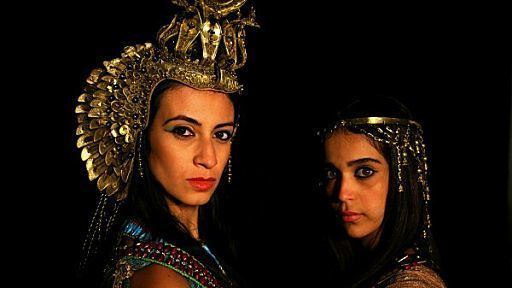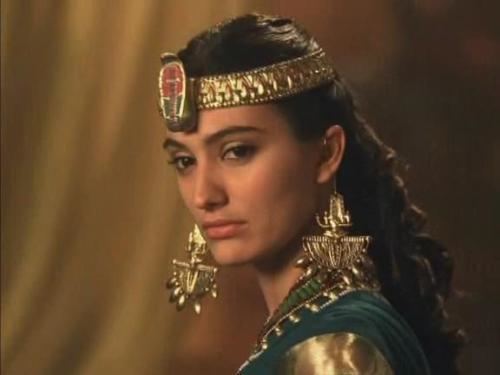Role Ruler | Name Arsinoe of Siblings Cleopatra | |
 | ||
Grandparents Cleopatra IV of Egypt, Ptolemy IX Lathyros Similar People Cleopatra, Ptolemy XIII Theos Philopator, Ptolemy XII Auletes, Berenice IV of Egypt, Ptolemy XIV of Egypt Born betw. 68–63 BC Alexandria, Egypt | ||
Arsinoe iv of egypt
Arsinoë IV (Greek: Ἀρσινόη, between 68 and 63 BC – 41 BC) was the fourth of six children and the youngest daughter of Ptolemy XII Auletes, and queen and co-ruler of Egypt with Ptolemy XIII from 48 BC – 47 BC, making her one of the last members of the Ptolemaic Dynasty of ancient Egypt. Arsinoë IV was the half-sister of Cleopatra VII and also a sibling of Ptolemy XIII.
Contents
- Arsinoe iv of egypt
- Whats inside the Tomb of Cleopatras sister Arsinoe IV of Egypt
- History
- Year of Birth
- Tomb at Ephesus
- References

What's inside the Tomb of Cleopatra's sister Arsinoe IV of Egypt ?
History

When Ptolemy XII died in 51 BC, he left his eldest son and daughter, Ptolemy and Cleopatra, as joint rulers of Egypt, but Ptolemy soon dethroned Cleopatra and forced her to flee from Alexandria. Julius Caesar arrived in Alexandria in 48 BC pursuing his rival, Pompey, whom he had defeated at the Battle of Pharsalus. When he arrived in Alexandria, he was presented with Pompey's head. The execution of his longtime friend and foe ended the possibility of an alliance between Caesar and Ptolemy, and instead he sided with Cleopatra's faction. He declared that in accordance with Ptolemy XII's will, Cleopatra and Ptolemy would rule Egypt jointly, and in a similar motion restored Cyprus, which had been annexed by Rome in 58 BC, to Egypt's rule and gifted it to Arsinoë and her youngest brother, Ptolemy XIV. Caesar had Ptolemy's regent, the eunuch Pothinus, executed while the general Achillas escaped and began besieging Alexandria.

However Arsinoë then escaped from the capital with her mentor, the eunuch Ganymedes, and took command of the Egyptian army, proclaiming herself Queen as Arsinoe IV, executing Achillas, who had assumed the title of pharaoh, and placing Ganymedes second in command of the army immediately below herself. Under Arsinoe's leadership, the Egyptians enjoyed some success against the Romans. The Egyptians had already trapped Caesar in a section of the city, by the building of walls to close off the streets, and she now directed Ganymedes to order the drawing of water from the sea, which was poured into the canals that supplied Caesar’s cisterns, causing panic among Caesar’s troops. Caesar countered this measure by digging wells into the porous limestone beneath the city that contained fresh water, which only partially alleviated the situation, so he then sent ships out along the coast to search for more fresh water there. Caesar realised he would soon have to break out from the city, and attacked the island of Pharos, upon which stood the great lighthouse. But Arsinoe's forces drove him back, inflicting upon him a humiliating defeat, in which Caesar himself was forced to tear off his armour and his purple cloak, and swim to the safety of a nearby Roman ship in the bay. However the leading Egyptian officers, having become disappointed with Ganymedes, and under a pretext of wanting peace, negotiated with Caesar to exchange Arsinoë for Ptolemy XIII, who was subsequently released. But Ptolemy continued the war, until the Romans received reinforcements and inflicted a decisive defeat upon the Egyptians.

Captive, Arsinoë was transported to Rome, where in 46 BC she was forced to appear in Caesar's triumph and was paraded behind a burning effigy of the Lighthouse of Alexandria, which had been the scene of her victory over him. Despite the custom of strangling prominent prisoners in triumphs when the festivities concluded, Caesar was pressured to spare Arsinoë and granted her sanctuary at the Temple of Artemis in Ephesus. Arsinoë lived in the temple for a few years, always keeping a watchful eye on her sister Cleopatra, who perceived Arsinoë as a threat to her power. In 41 BC, at Cleopatra's instigation, Mark Antony ordered Arsinoë's execution on the steps of the temple. Her murder was a gross violation of the temple sanctuary and an act which scandalised Rome. The eunuch priest (Megabyzos) who had welcomed Arsinoë on her arrival at the temple as Queen was only pardoned when an embassy from Ephesus made a petition to Cleopatra.
Year of Birth
Arsinoe’s year of birth is conjectural. The Encyclopedia Britannica cites 63 BC, making her 15 at the time of her victory over Julius Caesar and 22 at her death, while the researcher Alissa Lyon cites 68 BC making her 27 at her death. However, the Scottish archaeologist and presenter Neil Oliver reports in “Cleopatra: Portrait of a Killer” (2009), that forensic anthropologist Fabian Kanz of the Medical University of Vienna, examining her purported skeleton established her age at death (in 41 BC) as close to 18, indicating a birth year of 59 BC.
This last estimate makes Arsinoe just 11 at the time of her victory over Caesar. Nevertheless it is the only scientifically derived verdict, and further it does lend understanding to the spectacle in Rome, when the people, overcome by pity and sympathy for her, jeered Caesar when he paraded her in his triumph in 46 BC, and demanded that he spare her.
Her actions in the brief war against Caesar had suggested she was older than that, and purely in consequence of this, her date of birth had been placed between 68 BC and 63 BC. However this in turn would have made it impossible for her to be the woman buried in the octagon, and the possibility therefore remains that she was in fact as young as the scientific results suggest, and that she may have been just a figurehead rather than an active participant in the war, or, more likely, a child prodigy, a young person of inordinately high IQ, a quality already hinted at in her family by the multilingual and intellectual talents of her sister Cleopatra. Perhaps the strongest evidence that she was in fact exercising her own authority is that Caesar, after the Pharos debacle, was prepared to release Ptolemy XIII -- a male, who continued the war against Caesar -- just to get his hands on her.
Tomb at Ephesus
In the 1990s, an octagonal monument situated in the centre of Ephesus was proposed by Hilke Thür of the Austrian Academy of Sciences to be the tomb of Arsinoë. Although no inscription remains on the tomb, it was dated to between 50 and 20 BC. In 1926 a female body estimated to be between the ages of 15–20 years at the time of her death was found in the burial chamber. Thür's identification of the skeleton was based on the shape of the tomb, which was octagonal, like the second tier of the Lighthouse of Alexandria, the carbon dating of the bones (between 200 – 20 BC), the gender of the skeleton, and the age of the young woman at death. It was also claimed that the tomb boasts Egyptian motifs, such as "papyri-bundle" columns.
A DNA test was also attempted to determine the identity of the woman. However, it was impossible to get an accurate reading since the bones had been handled too many times, and the skull had been lost in Germany during World War II. Hilke Thür examined the old notes and photographs of the now-missing skull, which was reconstructed using computer technology by forensic anthropologist Caroline Wilkinson to show what the woman may have looked like. Thür concluded that it shows signs of African and Egyptian ancestry mixed with classical Grecian features – despite the fact that Boas, Gravlee, Bernard and Leonard, and others have demonstrated that skull measurements are not a reliable indicator of race.
A writer from The Times described the identification of the skeleton as "a triumph of conjecture over certainty". If the monument is the tomb of Arsinoë, she would be the only member of the Ptolemaic dynasty whose remains have been recovered. Forensic and archaeological analysis of the origins of the skeleton and tomb are ongoing.
